
After wandering around Edinburgh Castle, I thought: castles are really cool! I wanted to see more, and since I probably should be a confident user of the British transport system by now, I decided that I’d do a day trip out somewhere to see one. A bit of googling led me to Stirling Castle, a mostly-15th/16th century edifice less than an hour away by train. (I see now that I overlooked Craigmillar Castle, which was closer and looks even more castley. But aside from the castle it seems there wouldn’t have been so much to see there.) So I hopped on a little inter-urban train and headed for Stirling, getting a glimpse along the way of the Forth Bridge and the Falkirk Wheel.

Another attraction of Stirling — particularly since I’d never been to a battlefield before — was that the Battle of Bannockburn was fought near here, in 1314. So, when I arrived in Stirling, I went to the bus terminal to find out which one I needed to catch, which was when I encountered the first language difficulties of my entire trip.1 Inside the terminal, I asked the nice lady behind the information desk what bus I needed to catch for Bannockburn. She probably heard me say something like this: ‘G’day, scunge jumbuck bonza larrikin galah yakka, nahyeah?’ Whereas I heard her say something like: ‘Och aye, scunge tartan scone auld trews. Hoots mon!’ I thought I got a bus route number out of that, somehow, and headed out to the bus shelters. Then, when the bus came, I asked the driver if this was the one for Bannockburn. He looked a bit confused, and indicated no, so I grumpily headed back to the information desk to try again. But then one of the passengers got off the bus and called me back to tell me that it WAS in fact the right bus. He even told me when we reached the right stop. So, thank you, anonymous Scotsman!
Oh yeah, and that’s a statue of Robert the Bruce, who thrashed the English at Bannockburn.

There’s not a whole lot to see at the battlefield itself, unfortunately, which probably isn’t the battlefield anyway. (And I’m not sure what I was expecting to see, for that matter!) But there’s a small museum/visitor’s centre which was really very good, with dioramas and other displays explaining the whys and wherefores of all the battles fought around Stirling over the centuries (the other famous one being the Battle of Stirling Bridge in 1297, where William Wallace thrashed the English — bit of a theme developing there). The reason why there have been so many is because if you hold Stirling, you hold Scotland: partly because of its position athwart a major crossing of the Forth and between the Lowlands and the Highlands, and partly because of Stirling Castle itself, seen in the photo above. (Not that I actually realised that this was the castle when I took it!)

Right, so, this is back in Stirling proper, walking up the hill towards the castle. It’s the facade of a 16th-century townhouse built for the Earl of Mar, known as Mar’s Wark (‘wark’ being Scots for building).

Right next to Mar’s Wark is the Church of the Holy Rude (rude = cross — cf. Holyrood), the oldest parts of which were built in the early 15th century.

It’s where, in 1567, the infant James VI was crowned — by John Knox, no less. This makes it the only British church, still in use, which has been used for a coronation. If, the next time around, Westminster Abbey has been already been booked for another function, I’m sure the Church of the Holy Rude stands ready to take up the slack.
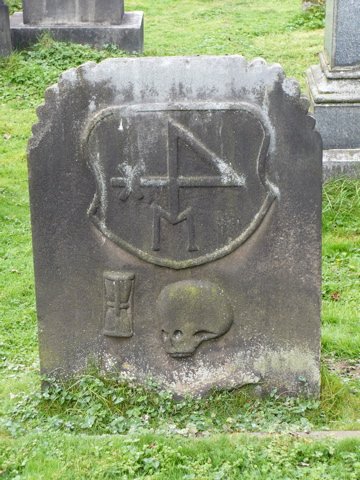
Lots of old headstones in the churchyard outside. Though this one is undated, I guess this is early 17th century or before, just based on the evolution of the styles — I don’t have much experience in reading early modern funerary iconography! The skull and crossbones, and the hourglass are pretty straightforward, but what about the symbol at the top? Looks vaguely astrological or alchemical, but I can’t match it up with anything. Or maybe it’s meant to represent 4-X-M — perhaps a clue to the identity of whoever is buried here, since otherwise there’s no name.
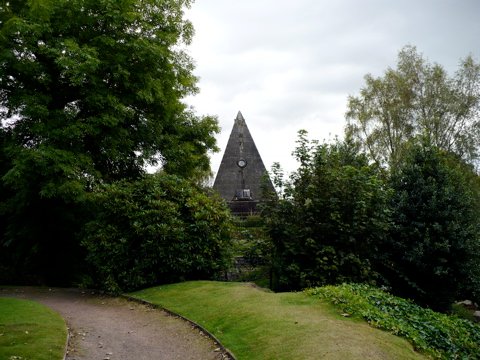
Also adding to the mystical feel: the Star Pyramid, which overlooks the church.

It was built in 1863 by William Drummond as a memorial to civil and religious martyrs … according to the internet. The inscriptions on it don’t have a very secular feel, however, which isn’t surprising since the Drummond family founded the Stirling Tract Enterprise, which provided religious literature to benighted heathens around the world.

Enough dilly-dallying, on to the castle! Now this is what a real gatehouse looks like (take note, Edinburgh Castle). It was built during the reign of James IV, early in the 16th century.
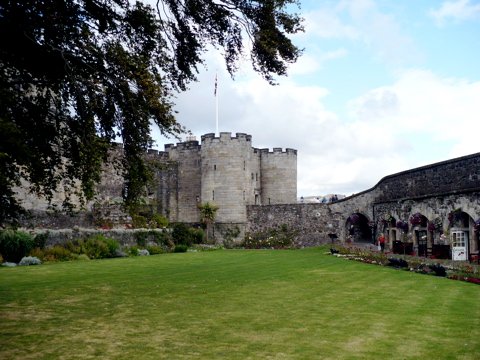
Another view of the gatehouse, from the 17th century bowling green. Like Edinburgh Castle, this was a royal palace as well a military fortress.
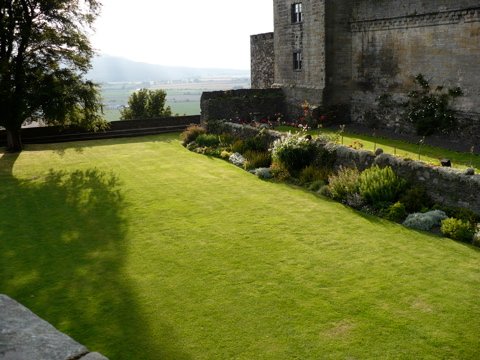
Still on the bowling green, but looking the other way, hinting at the magnificent vistas on the south side of the castle. More on those in a bit.
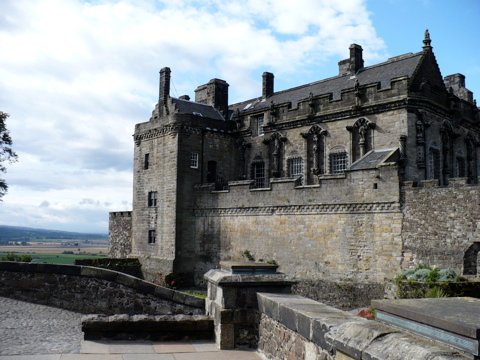
This is the palace begun by James V for his French wife, Mary de Guise, but finished by her after his death in 1542. The interior is being restored to how it would have looked in the 16th century — at the moment it’s pretty bare, but there are panels explaining the work of the archaeologists and restorers.

One of the stone figures guarding the palace, dirk in hand.

The Chapel Royal, built in 1594 — though in modern times it was a canteen for the soldiers stationed here! The decorations are reconstructed, not original.

The Great Hall (there’s always a Great Hall! though this is a big one, bigger than the one at Edinburgh Castle) dating from the start of the 16th century.

A little mermaid, part of a decoration over one of the Great Hall’s windows. (There’s a griffin as well.)

Inside the hall, with a German school group, I think they were. Check out the hammerbeam roof. The Army used the hall as barracks from the Napoleonic Wars up until 1964. The Navy was here too, in 1594 — well, not really, but to celebrate the christening of Prince Henry in the new Chapel Royal, a seafood was brought in on a wooden ship, complete with masts 40 feet high, armed with 36 brass cannon.

This tranquil garden was where the body of the 8th Earl of Douglas was dumped on 22 February 1452, after being murdered by James II and his courtiers, despite being promised safe conduct.
Of less historical interest, this spot is within a few metres of the closest I’ve ever come to the North Pole.

Let’s look at the defences. This is the Grand Battery on the eastern side. The last time Stirling Castle was besieged, in 1746, the guns here knocked out a Jacobite battery and forced Bonnie Prince Charlie to withdraw.

An array of cannon facing east. I think the battery closest is the Grand Battery.

The Nether Bailey on the northern side of the castle. The buildings on the left are powder magazines built in the 19th century. For some reason I didn’t realise that tourists were allowed down in the bailey, but they are, so it’s a pity I didn’t get to walk along the walls.

That the castle sits on top of a craggy rock helped make it more defensible. A lot more defensible, I’d say, judging from this. The castle was besieged many times, and fell more than once. The most famous siege (and fall) was in 1304, when Edward I brought a number of siege engines to bear upon it, including Warwolf, which was (according to a number of not very convincing websites) the largest trebuchet ever made.
The building in the photo is the King’s Old Building, built at the end of the 15th century, though it has changed a lot since then. It currently houses the regimental museum of the Argyll and Sutherland Highlanders (Princess Louise’s), who were garrisoned here for many decades. Their first battle honour was gained at the Cape of Good Hope in 1806; two hundred years later they were absorbed into the Royal Regiment of Scotland.
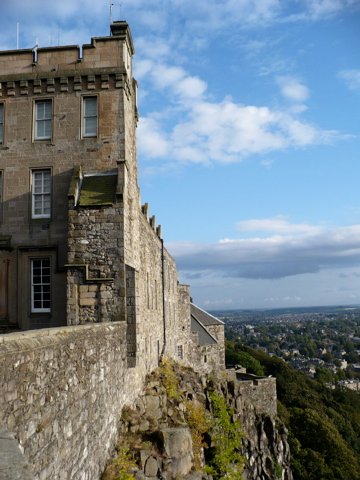
The other side of the King’s Old Building, looking back towards where the previous photo was taken.

South of the castle, the remains of a formal garden can be seen. The octagonal mound is the King’s Knot, which is about 380 years old (though I’m sure its been landscaped more recently than that, it’s in pretty good nick). It must have been very pretty from up here; I wonder why it hasn’t been restored, Hampton Court-style.
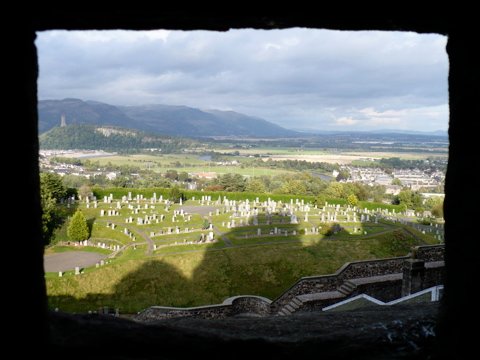
The other advantage to putting castles on top of hills is the view. Back then this would give advance warning of approaching armies. Nowadays it’s picturesque.

Actually, the views from Stirling Castle aren’t so much picturesque as astounding. This is the view to the north-east. The little tower in the lower left is the National Wallace Memorial, built in the 1860s to pre-commemorate Mel Gibson’s fight for Scottish independence. It’s not little at all, as it is 220 feet high. It definitely catches the eye, and I ended up taking a fair few photos with it in frame, such as the previous one (on the left) and the one at the top of the post, probably my favourite of the day.
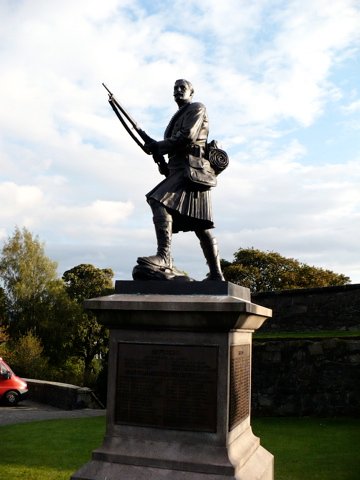
As should be apparent by now, I can’t go past a war memorial without taking a picture. This one, in the castle car park,2 is dedicated to those men of the 1st Battalion, Argyll and Sutherland Highlanders, who were killed in the Boer War.
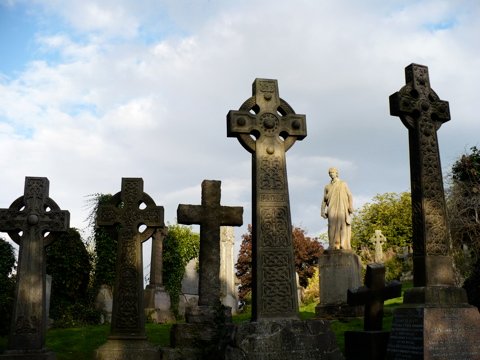
Walking back down to the station, I passed through the Valley Cemetery, adjacent to but separate from the churchyard (not sure if it’s connected to the cemetery three photos up, on the other side of the castle … seems like a popular place to go when you’re dead). Mostly 19th century graves, if I recall correctly, including this array of Celtic crosses, and the statue of the togate local worthy in the background.
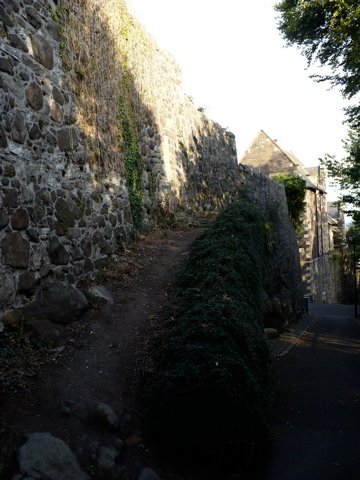
The ‘Back Walk’ into town runs alongside the remains of the city walls, which go back at least to the reign of Mary, Queen of Scots. They successfully defended the town on more than one occasion, though they didn’t stop Monck in 1651 or the Young Pretender in 1746. Very atmospheric in the late afternoon.
So, although it meant seeing less of Edinburgh, I was glad I made the effort to go to Stirling. One day I’ll come back and venture into the Highlands proper.
Coming up: my last full day in the UK …
![]() This work is licensed under a Creative Commons Attribution-NonCommercial-NoDerivatives 4.0 International License.
Permissions beyond the scope of this license may be available at http://airminded.org/copyright/.
This work is licensed under a Creative Commons Attribution-NonCommercial-NoDerivatives 4.0 International License.
Permissions beyond the scope of this license may be available at http://airminded.org/copyright/.

Fantastic photos. I’ve never been to Stirling. I’ll have to make a point of stopping there when I finally make my pilgrimage to Skara Brae.
Thanks, Alun. I was lucky with the weather, if I’d gone the next day it would have been overcast and gloomy.
I’d love to go see Skara Brae one day too … I managed to knock quite a few things off my ‘must-see’ list while I was over there, but it’s a very long list!
Great pics Brett. My family live around there so I have been many times. Is there still a statue of ‘Braveheart’ at the bottom of the Wallace monument. It was there many years ago.
Ross
Very nice indeed. Stirling really is bonny, isn’t it? And the Castle is much less gloomy and dreich than Edinburgh. It sound to me like you would be a big fan of Perth and all points north. Next time, eh? Some would argue that only from Perthshire onwards are you are moving into ‘real’ Scotland (at least in terms of scenery). And they could have a point there.
Ross:
I didn’t actually make it to the Wallace Monument, only gazed upon it from afar … but according to Wikipedia they were trying to sell it, due to its Mel Gibsoness.
Jack:
Yes, I did find Stirling Castle more pleasant than Edinburgh, though it may have had something to do with the relative lack of tourists! And I did think the hills I could see from Stirling looked inviting, so if the ‘real’ Scotland is anything like that then I probably would be a fan …
Yeah that would be the statue at the bottom. A likeness of Gibson. Quite funny really. It was done by a local artist as a bit od a joke. Kind of here is what you think he is and now lets see the real thing. The view from the top of the monument is great. The views are outstanding.
Ross
Is that thingy with the cannon balls on it a brass monkey?
(photo of the Grand Battery on the Eastern side)
BTW I do feel you have an alternative vocation here Brett – you’d make a mighty fine travel guide!
Don
Ross:
I can well imagine they would be. Next time!
Don:
Thanks, but it’s easy to sound knowledgeable about a place when you’ve got Google at your fingertips!
Actually I hadn’t heard ‘brass monkey’ used in this way … but Wikipedia is sceptical.
It’s interesting reading what someone from outside stirling has to say about it.